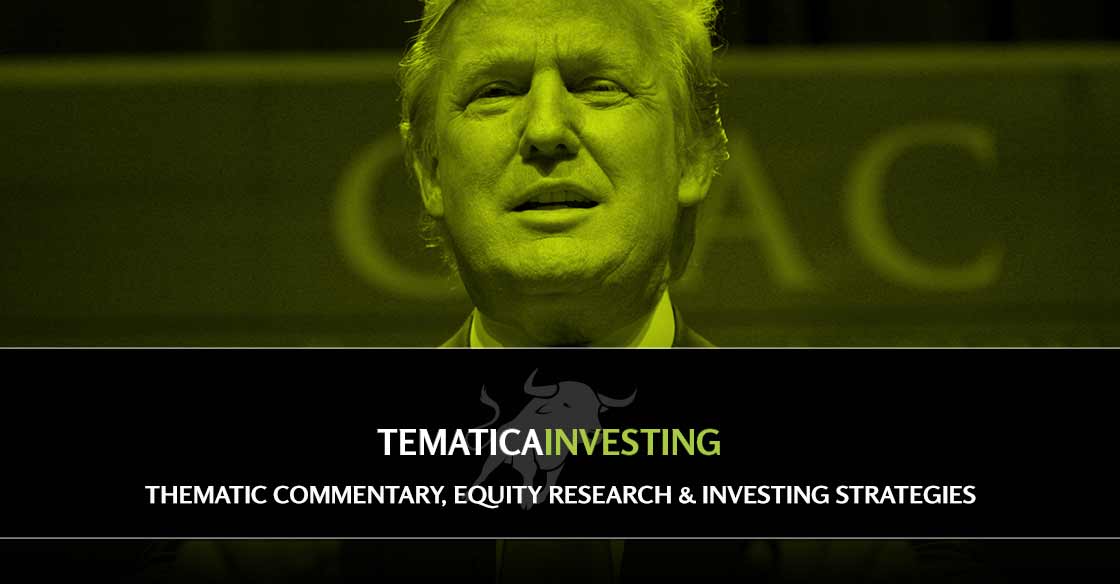WEEKLY ISSUE: Trade Concerns and Tariffs Continue to Hold Center Stage
Key Points From This Week’s Issue
- News from Harley Davidson (HOG) and Universal Stainless & Alloy Products Inc. (USAP) confirm tariffs and rising costs will be a hotbed of conversation in the upcoming earnings season.
- That conversation is likely to lead to a major re-think on earnings growth expectations for the back half of 2018.
- We are closing out our position in Corning (GLW) shares;
- We are closing out our position in LSI Industries (LYTS) shares;
- We are closing out our position in shares of Universal Display (OLED).
Trade concerns and tariffs taking center stage
As we saw in Monday’s stock market, where the four major U.S. market indices fell from 1.3% to 2.1%, trade wars and escalating tariffs increasingly are on the minds of investors. Something that at first was thought would be short-lived has grown into something far more pronounced and widespread, with tariffs potentially being exchanged among the U.S., China, the European Union, Mexico and Canada.
In last week’s issue of Tematica Investing, shared how the Tematica Investing Select List has a number of domestically focused business, such as Costco Wholesale (COST), Habit Restaurants (HABT) and recently added Farmland Partners (FPI) to name a few. While the majority of stocks on the Select List traded down with the market, those domestic-focused ones are, generally speaking, higher week over week. Hardly a surprise as that escalating tariff talk is leading investors to safer stocks like a horse to water.
I cautioned this would likely be a longer than expected road to trade renegotiations, with more than a helping of uncertainty along the way that would likely see the stock market gyrate like a roller coaster. That’s exactly what we’ve been seeing these last few weeks, and like any good roller coaster, there tends to be an unexpected drop that scares its riders. For us as investors that could be the upcoming June quarter earnings season.
As we prepare to exit the current quarter, there tend to be a handful or more of companies that report their quarterly results. These tend to offer some insight into what we’re likely going to hear over the ensuing months. In my view, the growing question in investors’ minds is likely to center on the potential impact in the second half of 2018 from these tariffs if they are enacted for something longer than a short period.
Remember that earlier this year, investors were expecting earnings to rise as the benefits of tax reform were thought to jumpstart the economy. While GDP expectations for the current quarter have climbed, the growing concern of late is the cost side of the equation for both companies and consumers. We saw this rear its head during first-quarter earnings season and the widening of inflationary pressures is likely to make this a key topic in the back half of 2018, especially as interest costs for businesses and consumers creep higher.
Harley Davidson spills the tariff beans
Well, we didn’t need to wait too long to hear companies talk on those tariff and inflation cost concerns. Earlier this week Harley-Davidson Inc. (HOG) shared that its motorcycle business will be whacked by President Trump’s decision to impose a new 25% tariff on steel imports from the EU and a 10% tariff on imported aluminum.
For Harley-Davidson, its duty paid on imported steel and aluminum from the EU will be 31%, up from 6%. The impact is not small potatoes, considering that the EU has been Harley’s second-largest market, accounting for roughly 16% of total sales last year. On an annualized basis, the company estimates the new tariffs will translate into $90 million to $100 million in incremental costs. That would be a big hit to the company’s overall operating profit, as its annualized March quarter operating income was $254.3 million. With news like that it’s a wonder that HOG shares are down only 6.5% or so this week.
Meanwhile, Universal Stainless & Alloy Products Inc. (USAP), a company that makes semi-finished and finished specialty steel products that include stainless steel, tool steel and aircraft-quality low-alloy steels, announced this week it would increase prices on all specialty and premium products by 3% to 7%. Universal Steel also said all current material and energy surcharges will remain in effect.
What does it mean for earnings in the 2Q 2018 quarterly reporting season?
What these two companies have done is set the stage for what we’re likely to hear in the coming weeks about challenges from prolonged tariffs and the need to boost prices to contend with rising input costs, which we’ve been tracking in the monthly economic data. In our view here at team Tematica, this combination is likely to make for a challenging June quarter earnings season, which kicks off in just a few weeks, as costs and trade take over the spotlight from tax cuts and buybacks.
Here’s the thing – even as trade and tariff talk has taken center stage, we have yet to see any meaningful change to the 2018 consensus earnings forecast for the S&P 500 this year, which currently sits around $160.85 per share, up roughly 12% year over year. With up to $50 billion in additional tariffs being placed on Chinese goods after July 6, continued tariff retaliation by China and others could lead to a major reset of earnings expectations in the back half of 2018.
If we get more comments like those from Harley Davidson and Universal Stainless, and odds are that we will, we could very well see those results and comments lead to expectation changes that run the risk of weighing on the market. We could see management teams offer “everything and the kitchen sink” explanations should they rejigger their outlooks to factor in potential tariff implications, and their words are likely to be met with a “shoot first, ask questions later” mentality by investors. That’s especially likely with the CNN Money Fear & Greed Index back in the Fear zone from Greed just a week ago.
I’m not the only one paying attention to this, as it was reported that Federal Reserve Chairman Jay Powell remarked that some business had put plans to hire or invest on hold because of trade worries and that “those concerns seem to be rising.”
Now there is a silver lining of sorts. Given the upsizing of corporate buyback programs over the last few months due in part to tax reform, any potential pullback in the stock market could be muted as companies scoop up shares and pave the way for further EPS growth as they shrink their share count.
I’ll continue to be vigilant with the Select List in the coming days so we’ll be at the ready to make moves as needed.
Doing some further Select List pruning
As we get ready for the 2Q 2018 earnings season that will commence with some fervor after the July 4th holiday, I’m going to take out the pruning shears and put them to work on the Tematica Investing Select List. As I mentioned above, odds are we will see some unexpected cautionary tales to be had in the coming weeks, and my thinking is that we should get ahead of it, remove some of the weaker positions and return some capital to subscribers that we can put to work during 3Q 2018. With that in mind, I am removing Corning (GLW), LSI Industries (LYTS), and Universal Display (OLED) from the Select List. in closing out these positions, I recognize they’ve been a drag on the Select List’s performance of late but we’ll also likely eliminate any further weight on the rest of the Select List.
- We are closing out our position in Corning (GLW) shares;
- We are closing out our position in LSI Industries (LYTS) shares;
- We are closing out our position in shares of Universal Display (OLED).


